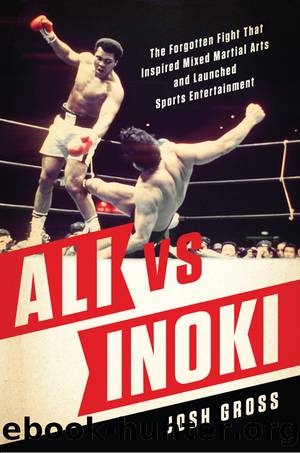Ali vs. Inoki: The Forgotten Fight That Inspired Mixed Martial Arts and Launched Sports Entertainment by Josh Gross

Author:Josh Gross [Gross, Josh]
Language: eng
Format: epub, azw3
Tags: Autobiography, Biography, Boxing, History, Martial Arts, Non-Fiction, Self-Defense, Sports & Recreation
ISBN: 9781942952206
Google: rPCGDAAAQBAJ
Amazon: 1942952198
Publisher: BenBella Books
Published: 2016-06-08T23:00:00+00:00
ROUND TEN
Pitting a heavyweight world champion boxer against the top Japanese heavyweight wrestler was professional wrestling’s way of saluting the American bicentennial. That’s what it said on the cover of the program that sold at arenas where live wrestling supported the American closed-circuit broadcast. The photo-heavy souvenir was clear about the night ahead. Under the simple headline “Wrestler Vs. Boxer,” the program explained that the broadcast was promoted by Top Rank, Inc., Video Techniques, and Capitol Wrestling Corporation (unmentioned were New Japan Pro Wrestling and Lincoln National Productions, Ltd.).
“Your local wrestling promoter has arranged this exclusive showing for this area,” it said.
Fans at Shea Stadium in Queens had the chance to see one half of the closed-circuit feed in person. As an appetizer to Ali vs. Inoki, thanks to Vince McMahon Sr. and the World Wide Wrestling Federation, boxer Chuck Wepner would meet iconic pro wrestler Andre the Giant. Meanwhile, WWWF heavyweight champion Bruno Sammartino’s emotional return from a broken neck got top billing at Shea.
Running the evening’s production and promotion, pro wrestling folks were in the midst of making a major statement about the future of their business.
The “WRESTLER VS. BOXER” program included images and quotes from the contract signing at the Plaza Hotel in Manhattan in March, laying out the expectations and relevance of the live pictures being beamed from inside the stifling Budokan Hall, and a ring above the Mets’ pitcher’s mound on the first Friday night of summer in Flushing, Queens. Ali vs. Inoki and Andre the Giant vs. Wepner “are the culmination of an effort to decide which sport has the superior fighters. Both will be seen here live tonight through the magic of television” the program promised in advance of a “history-making presentation.”
The technology that allowed audiences to view backto-back events as they happened on opposite sides of the globe came courtesy of Henry A. Schwartz. His Brooklynbased Video Techniques was basically alone in pulling the strings on major heavyweight closed-circuit fights since Ali–Frazier I in 1971. According to a piece published in New York Magazine ahead of the “Rumble in the Jungle,” Schwartz made money in more than a few ways as cable television penetrated American homes.
Forerunner to the pay-per-view business—which generated grotesque wealth in 2015 because of the promotion of Floyd Mayweather’s fight with Manny Pacquiao and a record setting year for the Ultimate Fighting Championship— Video Techniques monetized the lease and sale of projection equipment and technical services for satellite broadcasts, and Schwartz worked with Don King and Bob Arum to do all of Ali’s fights on closed circuit.
In 1974, Schwartz found the money to put on Ali– Foreman in Zaire, and joined with King to sell the fight. The “Rumble in the Jungle” was seen perfectly in 390 closed-circuit locations in North America and in nearly one hundred countries worldwide. At Madison Square Garden, seats to watch ranged from twenty to thirty dollars. Ali and Foreman were set to split a $10 million purse, double Ali’s take versus Frazier three
Download
Ali vs. Inoki: The Forgotten Fight That Inspired Mixed Martial Arts and Launched Sports Entertainment by Josh Gross.azw3
This site does not store any files on its server. We only index and link to content provided by other sites. Please contact the content providers to delete copyright contents if any and email us, we'll remove relevant links or contents immediately.
| Baseball | Basketball |
| Boxing, Wrestling & MMA | Football |
| Golf | Hockey |
| Soccer |
Imperfect by Sanjay Manjrekar(5412)
Wiseguy by Nicholas Pileggi(4586)
Tuesdays with Morrie by Mitch Albom(3832)
The Body: A Guide for Occupants by Bill Bryson(3801)
Unstoppable by Maria Sharapova(3118)
Crazy Is My Superpower by A.J. Mendez Brooks(2860)
Not a Diet Book by James Smith(2726)
Into Thin Air by Jon Krakauer(2701)
The Mamba Mentality by Kobe Bryant(2669)
Finding Gobi by Dion Leonard(2260)
My Turn by Johan Cruyff(2244)
Tuesdays With Morrie by Mitch Albom(2172)
The Fight by Norman Mailer(2159)
Unstoppable: My Life So Far by Maria Sharapova(2128)
The Ogre by Doug Scott(2114)
Accepted by Pat Patterson(1917)
The Quarterback Whisperer by Bruce Arians(1846)
Everest the Cruel Way by Joe Tasker(1827)
Open Book by Jessica Simpson(1795)
